Note: The following text was originally posted on my X/Twitter account.
While the PLA Air Force's (PLAAF) JL-1 air-launched ballistic missile is smaller and lighter than many of the ballistic missiles and related systems operated by the PLA Rocket Force (PLARF), it is an extremely large and heavy external air-launched payload that is exclusively carried by the PLAAF's specially-configured H-6N bombers on a semi-recessed centerline station. The formal unveiling of the JL-1—observers were previously limited to no clearer image than image 3—offers a clear view of suspension lugs, which are used to attach the JL-1 to the H-6N bomber in a manner that is likely to result in the H-6N being in an overloaded state should its fuel tanks be filled (which is likely to be the primarily reason for the installation of the aerial refuelling probe).
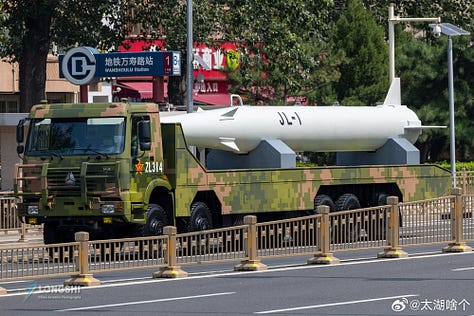
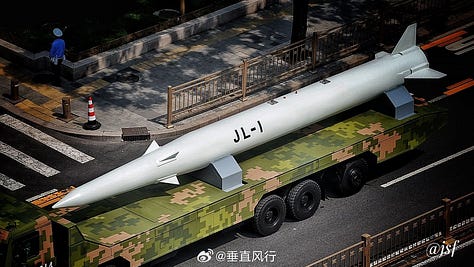
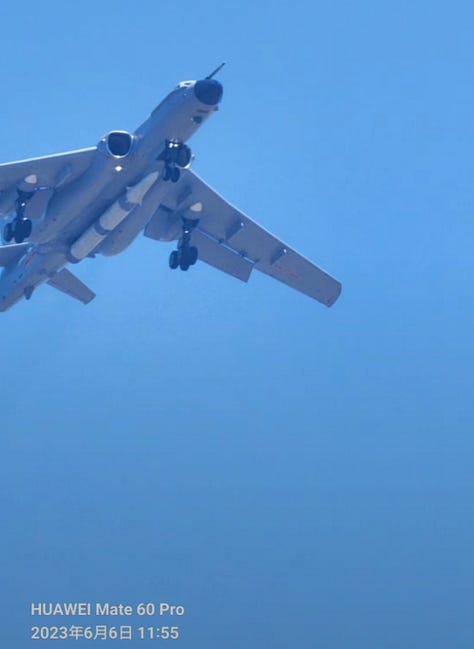
As a general matter, it is important to point out that the specially configured—heavily modified—H-6N is not very well-suited for use as an air-launched ballistic missile carrier. A larger bomber aircraft design with weapons stations on its wings that have much more permissive weight and volume restrictions, such as the American B-52, is better-suited to carrying multiple oversized payloads. Image 4 shows a B-52H carrying two AGM-183 ARRW air-launched boost-glide vehicle/hypersonic boost glide vehicle (BGV/HGV) on its port wing. Should the PLAAF remain interested in air-launched ballistic missiles and similar—including the likes of air-launched boost glide vehicles/hypersonic glide vehicles (BGV/HGV)—going forward, it will likely require a new bomber aircraft design other than the reportedly in development and forthcoming H-20, which is widely thought to be a flying wing low observable design in the vein of the American B-2 and B-21.
The combination of the specially-configured aerial-refuelling capable H-6N bomber and the likes of the JL-1 air-launched ballistic missile is understood to be the primary current manifestation of the PLA Air Force's (PLAAF) (re)adoption of a nuclear strike role, a development that offers China a so-called nuclear triad after decades of heavy—in practice near-total—reliance on ground-launched nuclear-armed ballistic missiles. While the PLAAF currently appears to be turning to air-launched ballistic missiles to deliver nuclear warheads, it may come to deploy nuclear-armed air-launched cruise missiles for its future bomber aircraft going forward.
The subsonic turbofan-powered H-6N and the underlying turbofan-powered H-6K are the latest Chinese derivatives of the 1950s-origin turbojet-powered Soviet Tupolev Tu-16 bomber aircraft design. While the longevity of the Tu-16 design in Chinese service is often spoken of in the same light as the U.S. Air Force's ongoing use of the 1950s-origin B-52 bomber aircraft design, the Tu-16/H-6 is best characterized as a medium bomber design, while the B-52 is best characterized as a heavy bomber design. The latest B-52H—a highly modified version of airframes that were built through the early 1960s—is likely to have a maximum take-off weight (MTOW) that is over 200% that of the closely related turbofan-powered H-6K and H-6N, the production of which continued into the 2020s. The difference in MTOW between the H-6N and B-52H is broadly comparable to the difference in MTOW between a late model Boeing 737 airliner and a late model Boeing 767 airliner.
All things considered, the H-6N design is severely limited in terms of payload-range and range-endurance and cannot be employed in the highly flexible manner that the USAF employed the versatile B-52 design throughout the Cold War and to the present day. Given the prevailing threat environment, China's military-geographical context, and the logistical realities associated with operating the likes of the H-6N and even the American B-52H from China to attack distant targets, the H-6N requires a very long-range standoff strike munition to target Hawaii and the continental United States. The JL-1 appears to be one of at least two air-launched munitions that the H-6N can carry on its single semi-recessed centerline (external) weapons station—the other is a boost-glide vehicle/hypersonic glide vehicle design.
There is no public indication of the existence of a nuclear-armed air-launched cruise missile for the H-6N, and the aforementioned considerations indicate why this is likely to be the case. The PLAAF is, however, likely to acquire a nuclear-armed air-launched cruise missile for the reportedly forthcoming H-20 bomber aircraft, which is widely thought to be a flying wing low observable design in the vein of the American B-2 and B-21. Such a bomber aircraft design will be limited to carrying munitions in one or more internal bomb bays. The JL-1 is an extremely large—oversized munition—such an air-launched ballistic missile is an unlikely candidate for carriage by the reportedly forthcoming H-20 bomber.
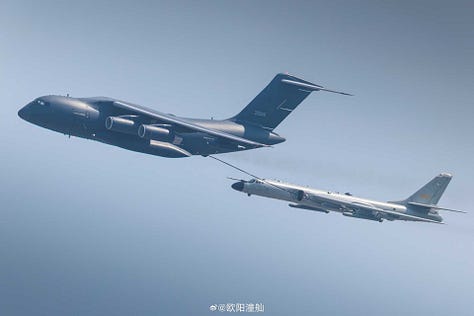
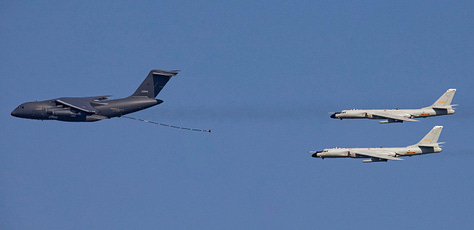
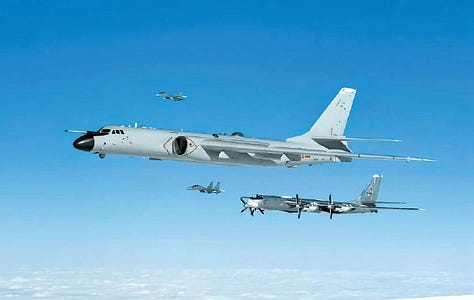
While the air-launched ballistic missiles have certain advantages over air-launched cruise missiles, ballistic missiles employ rockets for propulsion that are inherently inefficient and uneconomical by virtue of carrying the weight and volume of oxidizer necessary for combustion within the missile. A prospective Chinese nuclear-armed air-launched cruise missile design is, in contrast, likely to use an air-breathing propulsion system such as a turbofan engine or a ramjet engine that makes use of atmospheric oxygen as oxidizer. All else being equal, a munition equipped with an air-breathing propulsion system of a given range-payload class is going to be much smaller and lighter—and more suitable for internal carriage—than a munition that is equipped with a non-air-breathing propulsion system, namely a liquid-propellant rocket engine or solid-propellant rocket motor.
The PLAAF's future course will, of course, be shaped by the various other considerations at play, above all those concerning the logistical realities of having an H-20 bomber/a future PLAAF bomber design more generally take off from China to target Hawaii and/or the continental United States and the nature of envisaged American air and ballistic missile defence capabilities. It is, therefore, possible that H-20 bombers/a future PLAAF bomber aircraft design, more generally, will be equipped with a smaller and lighter nuclear-armed air-launched ballistic missile design. It is important to note that a subsonic air-launched cruise missile is not the only option available to China. The recent parade was used to unveil the new and previously unseen YJ-19, which is reported to be a sustained supersonic/hypersonic high-altitude anti-ship cruise missile that is equipped with a reported air-breathing scramjet (i.e., supersonic combustion airflow ramjet) engine. While the YJ-19 is reliant on a large and heavy (non-airbreathing) solid-propellant rocket booster as its booster, it amounts to another approach that China can pursue to equip its future bomber aircraft with nuclear-armed air-launched strike munitions that are very different than the likes of the very large and bulky JL-1 air-launched ballistic missile.

